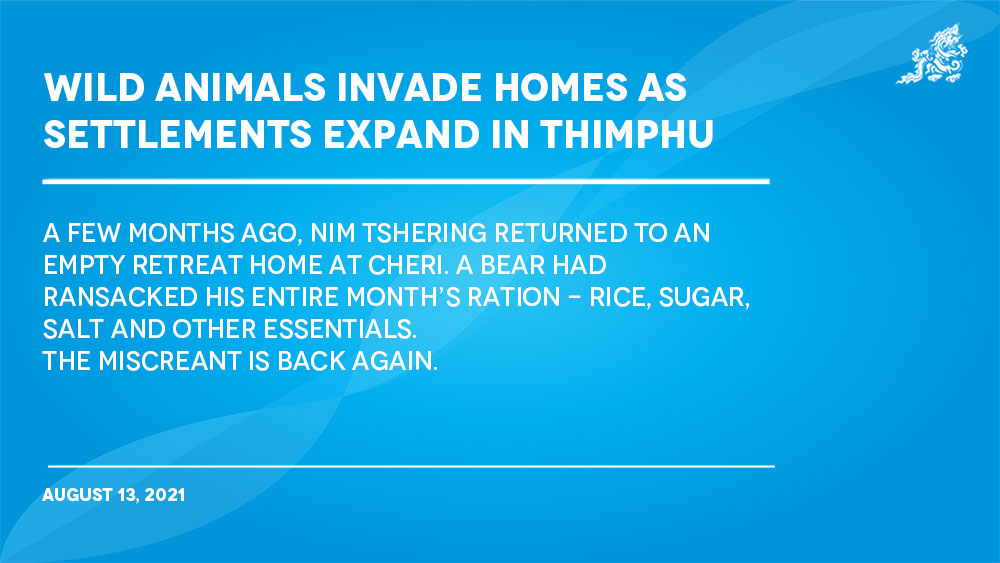Chhimi Dema
A few months ago, Nim Tshering returned to an empty retreat home at Cheri. A bear had ransacked his entire month’s ration – rice, sugar, salt and other essentials.
The miscreant is back again.
Nim Tshering, 60, from Paro, has learned to still sit in his retreat whenever bears approach his retreat centre. “If you do not provoke, nothing happens. They leave,” he said.
Over the past week, residents in Jemina and Chamjeykha, both places within a 30 minutes drive from Thimphu city, sighted bears. Although lives were not lost, they were seen to enter orchards and kitchen gardens, even rummaging through garbage.
Thimphu forest division chief, Gyeltshen Dukpa, the urban encroachment of the wild animals’ habitat was forcing the animals to come closer to human settlement.
“With developmental activities such as the construction of roads, animals’ habitats are lost, and food that was previously available are now scarce,” he said.
That is why, he said, they are compelled to come closer to human settlement for food.
A report from the UN environment programme and the World Wildlife Fund, ‘A future for all–the need for human-wildlife coexistence’, recognises human population dynamics, land-use change, linear infrastructure as some of the drivers that lead to the human-wildlife conflict (HWC).
The report stated that humans and wildlife may be able to share space more harmoniously if the global community collaborates for HWC management and if new policies strike a balance between mechanisms that deter negative human behaviour towards wildlife and those that promote and enable tolerance.
It is not possible to completely eradicate HWC, the report stated. “But well-planned, integrated approaches to managing it can reduce conflicts and lead to a form of coexistence between people and animals.”
Gyeltshen Dukpa said that there was no permanent solution to such conflicts. “We have to keep looking for alternate solutions.”
The division plans to use noise from firecrackers to chase bears. If it doesn’t work, he said that they would look for other alternatives.
Cheri retreat homes have electric fencing but it was becoming ineffective. The bears dug holes under the fence or used trees to jump over it.
Some residents tried blaring music to scare them away. Huge lights were installed yet they have been returning to the settlements at night looking for food.
Along with Himalayan black bears, other animals such as musk and sambar deers, wild boars, and tigers were sighted in the past few months around Thimphu, according to forestry officials.
Officials said that deers were often chased by wild dogs, pushing them towards settlement areas. The deers were rescued and kept at the Motithang Takin Preserve.
Another contributing factor that brings deers closer to human settlement is stray dogs, Gyeltshen Dukpa said.
“Deers are chased by stray dogs that hunt in packs also hampering deer conservation efforts,” he said, adding that this eventually would imbalance the prey and predator relationship, drawing more carnivorous animals towards human settlements for food.
Records show that livestock depredation by wild carnivores including leopard, tiger, Himalayan black bear, and dhole cost farmers an average financial loss of 17 percent of their total per capita cash income.
Gyeltshen Dukpa said that when people report to them, people expect the division to harm the wild animal.
“If the animal was hurt then we can tranquilise and bring them to the rehabilitation centres for recovery,” he said. “It was not possible to tranquilise healthy animals and relocate them because they would pose the same threat elsewhere.”
The division urges people to avoid early morning and late evening walks if they live near forest.
Edited by Tshering Palden


